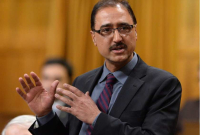Support strong Canadian climate journalism for 2025
The Trudeau government is trying to dispel fears about its plan to tap some of the world's wealthiest institutional investors to help fund infrastructure projects in Canada.
In an interview Tuesday, Infrastructure Minister Amarjeet Sohi said the plan will not inevitably mean imposing road tolls and fees just to ensure that private investors can reap a return on their investments. Moreover, he played down concerns that it could lead to state-owned foreign enterprises from countries like China controlling strategic infrastructure in Canada.
And he insisted the government won't leave in the cold smaller projects that won't provide any return on investment. Such fears have been raised repeatedly since the federal government announced its intention to create an infrastructure bank, aimed at leveraging $4-5 in private-sector funding for every $1 in government funding.
And they intensifed in the wake of Prime Minister Justin Trudeau's summit Monday with some of the most powerful institutional investors in the world, representing a combined capital pool worth $21 trillion. He also met with some of Canada's largest investors, including insurance companies, the big banks and pension funds.
"If foreign billionaires loan the Canadian government money for bridges, hospitals and schools, they are not going to do it out of the goodness of their hearts," interim Conservative leader Rona Ambrose told the House of Commons on Tuesday. "They are looking for a return. Jobs will be a cost that is kept to a minimum and taxpayer dollars will come second to their profits whenever a project goes over budget."
New Democrat MP Rachel Blaney accused the Liberals of hiding their "privatization scheme" from voters during last year's election. And she asserted that the "only way" private investors will get a return on their investments "is through tolls and user fees for Canadians."
But Sohi said Tuesday it's not up to the federal government to decide whether to impose user fees on infrastructure projects built with financing from private investors.
"The infrastructure that my department supports is owned by municipalities and provinces ... so that decision, how to finance, how to price and how to pay for it, is not our decision," he said in an interview. "It is the decision of the local jurisdictions."
Government officials further explained that the infrastructure bank is intended to help provinces and municipalities fund projects that will provide a revenue stream from which the private investors can make a return on their investment. But they said there are many ways to do that, beyond imposing new user fees.
For instance, projects to mitigate the effects of climate change or to build public transit stations could be linked to commercial development in the surrounding areas, thereby providing revenue streams. Or construction of a resource road could be linked to the investor's eventual gain from the development of the resource that would become accessible.
Canadians already pay to use public transit or electricity transmission so private investment in new projects in those areas wouldn't change anything. Nor would the bank mean mass privatization of public infrastructure.
An example of the kind of project that could be accomplished through the bank was offered in Finance Minister Bill Morneau's economic and fiscal update earlier this month: Vancouver's Canada Line rapid transit project, which was financed by a public-private partnership. The Greater Vancouver Transportation Authority retains ownership of the line and payments to the private investors are tied to ridership and performance targets.
"By partnering with the private sector and ensuring payments are made based on performance, the project was expected to achieve around $92 million (net present value) in savings, compared to the cost of having the public sector develop and deliver the project alone," the statement said.
Sohi said he's "not at all" concerned that many necessary but smaller projects will go begging because they won't be able to provide sufficient — or any — returns to attract private investors. Those projects will still be eligible to tap into the vast majority of the federal government's planned $186-billion infrastructure funding over the next 12 years.
"When you look at the amount of investment we are making ... out of that only $15 billion is being allocated to the (infrastructure) bank. That's less than eight per cent of our commitment," he said. "So the vast majority of the infrastructure support that we provide will be delivered through traditional ways of giving grants to municipalities, through bilateral agreements or national programs."
The $15 billion is for direct federal investment in projects. The government is also pledging to put up another $20 billion in loans, loan guarantees, equity investments and repayable contributions, for a total of $35 billion pumped into the infrastructure bank. The government hopes to leverage both envelopes of money by partnering with private capital, but does not expect the $15-billion "concessional" tranche to be as lucrative as the $20-billion tranche.
Among the participants at Monday's investors summit were two Chinese state-owned enterprises, the China Investment Corp. and the State Administration of Foreign Exchange. That raised questions about the potential for state-owned enterprises winding up controlling strategic Canadian infrastructure like energy grids or pipelines.
But Sohi played down such concerns.
"We also have very strong, sound foreign investment rules and they will come into play when we design the bank," Sohi said. "So I think it's very premature at this time to even talk about which investors are going to invest in Canada."
The government has promised to relax foreign investment restrictions somewhat, raising to $1 billion the threshold at which a foreign investment must be reviewed. The projects to be funded by the bank are expected to top $1 billion and thus would require review.




Comments